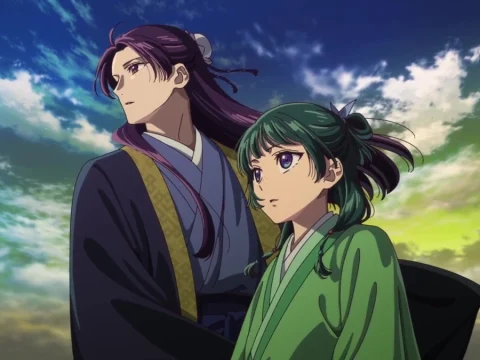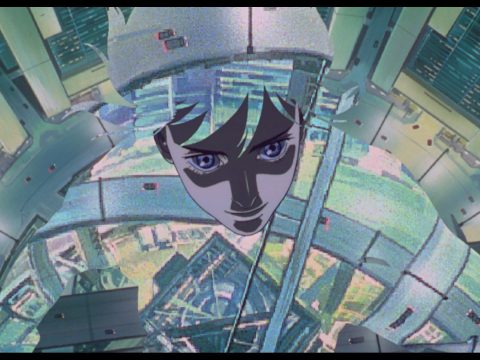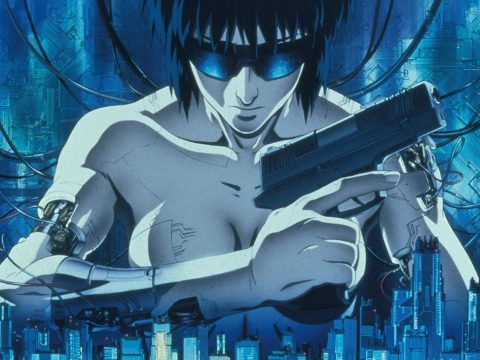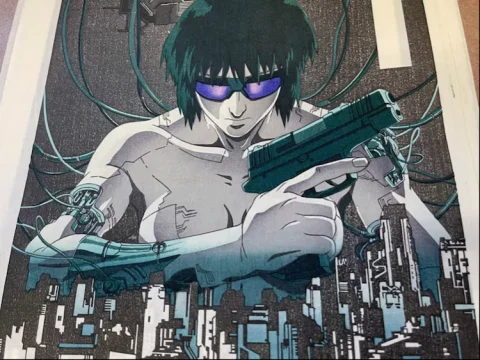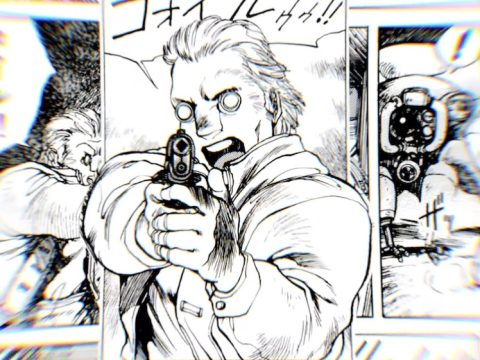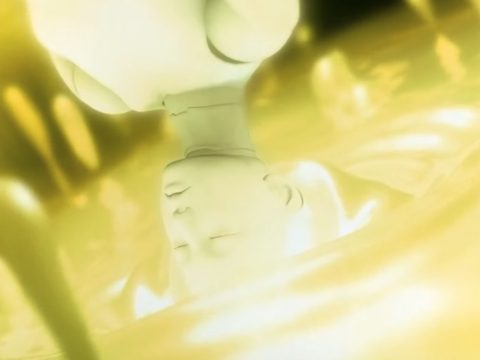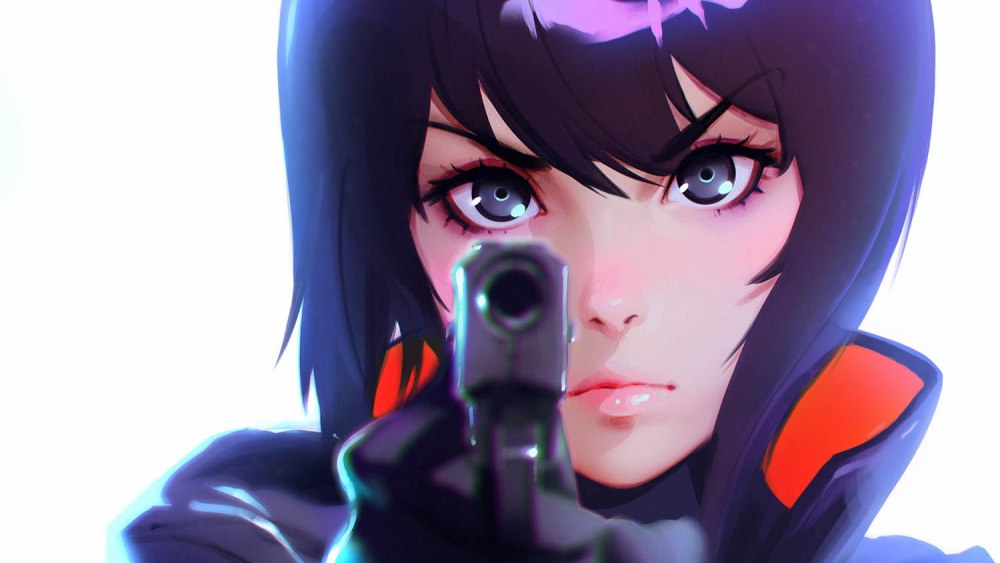 Anyone who writes science fiction has to worry about the present overtaking their futuristic fantasies. It’s particularly true for a franchise like Ghost in the Shell, which is over 30 years old (the first chapter of the manga came out in April 1989) and has developed through events like the collapse of Japan’s bubble economy, the Lost Decade(s), the increased deployment of Japanese self-defense troops abroad, and seventeen prime ministers, just to name a few. Although Ghost in the Shell has maintained its core team of Major Motoko Kusanagi, Batou, and the rest of the counterterrorism group of Section 9 trying to keep the peace (to a greater or lesser degree), all of its various permutations have responded to world developments as well as the visions of their creators and interpreters.
Anyone who writes science fiction has to worry about the present overtaking their futuristic fantasies. It’s particularly true for a franchise like Ghost in the Shell, which is over 30 years old (the first chapter of the manga came out in April 1989) and has developed through events like the collapse of Japan’s bubble economy, the Lost Decade(s), the increased deployment of Japanese self-defense troops abroad, and seventeen prime ministers, just to name a few. Although Ghost in the Shell has maintained its core team of Major Motoko Kusanagi, Batou, and the rest of the counterterrorism group of Section 9 trying to keep the peace (to a greater or lesser degree), all of its various permutations have responded to world developments as well as the visions of their creators and interpreters.
What follows is my completely subjective ranking of the various envisionings of the worlds of Ghost in the Shell (recently voted #1 cyberpunk anime by readers of Otaku USA), from worst to best. And I’d take “worst” with a grain of salt, here. Even at its least-engaging, I’ll take most versions of Ghost in the Shell before a lot of the other stuff that’s out there.
7. Ghost in the Shell: Arise (2013-2015)
When Arise came out, Ghost in the Shell had already been through three films, two TV arcs, and a slew of novels and games in addition to Masamune Shirow’s manga. At that point, creating a new origin story for Kusanagi and her compatriots, with new voice actors stepping into these roles was definitely a risk, and unfortunately, it was one that didn’t quite pay off.
One of the reasons I mentioned politics and the Japanese self-defense forces in the intro is that Ghost in the Shell has always been a very political beast. Masamune Shirow’s original manga deals heavily with political machinations both geopolitical as well as those internal to Japan. While Arise generates some dramatic action scenes, having the core of the story be about the squabbles between different corporations and government agencies drastically lowers the stakes since it’s so hard to care which side wins in the end. And it’s not just the internal power struggles that threaten to derail Arise. I really hate the term “technobabble” because it’s too often used by people who haven’t paid close enough attention to what’s going on, but that’s probably the best term to describe Arise’s take on its technological future.
Another reason Arise comes in last here is due to how it was released. It was the first Ghost in the Shell OVA series, released in four increments in 2013 and 2014. The series was then recut into a television series called Alternative Architecture, changing the chronology of the events and adding additional material (which later was released in Japan as an OVA of its own). Surprisingly, given the popularity of Ghost in the Shell in general, Alternative Architecture never received a physical release in North America (although the first four OVAs did), perhaps indicating a lack of enthusiasm over the series.
I’m going to throw Ghost in the Shell: The New Movie into the list at this point as well, since it’s really a continuation of the Arise series and doesn’t stand alone, as it were. In my day job working in IT, I’m careful to never name anything that I’m going to be keeping around for a while with the tag “new.” I’ve had to work with mainframe databases over two decades old that are still called “new” just because what they were replacing at the time just happened to be older. The chosen name for the movie finale for the Arise saga smacks of desperation more than anything else, as if they’re trying to flee the baggage of the rest of the series but can’t really come up with anything better.
6. Ghost in the Shell: SAC_2045 (2020-)
If Arise was a risk, with its new take on familiar characters, SAC_2045, the most recent take on Ghost in the Shell, is like revisiting old friends. We’re back to the characters of the Stand Alone Complex chronology and the voices that we’ve been familiar with for nearly 25 years. Unfortunately, this familiarity means that some of the differences present in SAC_2045 are even more jarring.
Yes, I have to talk about the animation. Sigh. The animation. Ghost in the Shell has always dabbled in 3D CG animation, from the very first film to the opening credits of the first Stand Alone Complex season. However, SAC_2045 is the first full CG Ghost in the Shell series, and unfortunately it looks shockingly subpar. While there aren’t any laugh-out-loud CG errors like in the recent Berserk series, the whole thing seems too smooth and unfinished, both with regard to the characters and their environments. Camera movements sometimes seem unnatural and too languid, as if they’re trying to pad out a required running time, and the editing choices are occasionally baffling.
However, I can overlook a lot if the story and writing are good. I mentioned the problem that science fiction can have with getting overtaken by history. In the case of SAC_2045, with its references to the rich “one percent” and an episode titled “EDGELORD – The Revolution of the 14-year-olds,” it seem like the series is trying too hard to be “current,” which is not where science fiction should be aiming, especially for a series ostensibly set 25 years in the future. Some of the other Ghost in the Shell series have shown how to tackle issues that are both contemporary and timeless, something to which SAC_2045 should perhaps pay a bit more attention.
In spite of these reservations, and although the first half of the story takes too long to really get going, by the end of episode 12 they have begun to construct a really engaging mystery. I’m genuinely curious to see where it’s headed and want to see more, something I didn’t expect to find myself saying after the first couple episodes. There’s still another half of the series left to go, though, and I’m not entirely convinced they won’t blow it. However, I really want it to do well, and if it sticks the landing I could even see SAC_2045 moving up a place or two if I were to revisit this list later on.
5. Ghost in the Shell: Stand Alone Complex – Solid State Society (2006)
Since I threw The New Movie into the ranking alongside the rest of Arise, you may be wondering why Solid State Society gets its own entry, since it’s the film that followed the first two Stand Alone Complex seasons. Although SSS falls into a bit of the same trap that Arise does, getting a bit too self-satisfied with its own political complexities, it does exist as its own thing rather than as a mere extension of the previous Stand Alone Complex escapades.
One of the strengths of SSS is that it demonstrates some genuine character development after the end of the 2nd Gig series. Kusanagi has left Section 9 and has ventured out on her own. Without the Major to rein him in, Batou has become something of a lone wolf (a development that we can also see in Innocence). Of all the characters, Togusa is perhaps the most interesting here, as he develops into a leader and manager of the sometimes-unruly Section 9. Although Aramaki is still at the top, it becomes Togusa who holds the team together and gives them direction on a daily basis. Even rewatching it after all this time, I still get a little emotional during the hallway scene with Togusa and his daughter. It’s a good film that can make you care about a character in this way. I just wish other aspects of SSS held together as well. It’s not that it’s a bad film, but it doesn’t have much of substance to say, which is a bit of a letdown following the phenomenal second season of Stand Alone Complex.
4. Ghost in the Shell: Stand Alone Complex (first season) (2002-2003)
When the first season of Stand Alone Complex came out in 2002, we had only seen a tiny bit of Ghost in the Shell in animated form. There had been Mamoru Oshii’s 1995 film, of course. There was also the animated introduction and interstitials for the PS1 Ghost in the Shell game in 1997. (It is still the animation that comes closest to replicating the look and feel of Masamune Shirow’s manga.) There was so much more in the Ghost in the Shell world yet to be explored.
Stand Alone Complex provided a great point of entry to a re-envisioning of a near-future world that was a bit brighter and perhaps more optimistic than Oshii’s film had been. Director Kenji Kamiyama had been working in the anime industry for over a decade when he got the chance to helm SAC, his first major work as a director. However, Kamiyama proved himself more than up to the challenge, giving the series a lighter flavor that could appeal to a wider audience than the previous feature film. Still, Kamiyama remained indebted to Oshii’s approach, saying: “The Ghost in the Shell TV series inherited many aspects from Director Oshii. I didn’t try to distinguish myself from Director Oshii, Instead, I totally tried to copy him.”
Rather than focus on one aspect of the Ghost in the Shell world, Stand Alone Complex threw a little bit of everything into the mix – a little bit of thriller, a bit of philosophy, some literary allusions, of course geopolitics, and even a taste of futuristic romance. For everything that SAC was trying to do, and given Kamiyama’s relative directorial inexperience at the time, the series shouldn’t come together as well as it does. I really wish they had given Kusanagi some pants in this series, though. She must be cold.
3. Ghost in the Shell (1995)
The tagline shown on one of the movie posters for Ghost in the Shell read “People love machines in 2029 AD.” Personally, I’m excited. That’s just a few more years away. I’m sure that must have sounded pretty futuristic back in 1995, though. I have a feeling that we won’t see a world like we see in the film in another nine years, but of course anything could happen.
The original Ghost in the Shell may be the single film I’ve seen the most often. It’s one of those that I’m always game to watch because I’ll find myself picking up on some detail that I’d missed before. In it, Mamoru Oshii transforms Masamune Shirow’s cyberpunk romp into a far more somber affair that trims away the fat for a reflection on the nature of the self.
When I put it like that, it seems amazing that the film has been as popular as it was. For decades the fact that Ghost in the Shell topped the Billboard sales charts in the US has been a selling point both in the US and Japan. (I still see this fact repeated in Japanese on occasion to this day.) However, the success of Ghost in the Shell wasn’t a historical fluke. Even if the director and other members of the creative staff didn’t have an international audience in mind when they were working on it, the producers certainly had their eyes on markets outside Japan.
In 2008 a revamped version called Ghost in the Shell 2.0 was released. This new version took the original and altered certain scenes to redo them with 3D CG animation, which unfortunately doesn’t mesh well with many of the surrounding scenes. It also reworked the entire color palette of the film, giving it an amber hue rather than the green of the original. I think there were two main reasons for this — the color change tied the film aesthetically closer to some of Oshii’s subsequent work like Avalon, while simultaneously distancing it from The Matrix, which had taken a lot of the film’s aesthetics and even duplicated a few scenes.
2. Ghost in the Shell 2: Innocence (2004)
Although Innocence appears here in the penultimate position, it’s probably my favorite piece of Ghost in the Shell media. Like the 1995 film, it adapts some of the events of Masamune Shirow’s original manga, but it puts a completely different spin on things. Rather than a futuristic police procedural, it becomes an investigation into longing and what it means to be human. The plot of the film may depict Section 9 trying to solve a series of murders, but the film is really about a lonely man searching for the only person who ever meant anything to him, and how relationships can transcend species and technology. It’s deep, man.
At least, that’s my take on things. I can also empathize with those who have no patience for director Oshii’s various philosophical meanderings and literary allusions. I can completely understand those who would want to throw the word “pretentious” at this film, although I’d strongly disagree. It’s not just pretending to have great significance, it does actually have the depths of meaning it thinks it does. It’s not trying to be accessible, and that’s what I love about it. I could go on and on, using Innocence as a jumping off point to engage with all manner of philosophical speculation, to plumb the depths of knowledge and weave new tapestries of thought. See, this film gets me all worked up.
Although I think every film should stand on its own and not require the knowledge of what might have happened in other media, I also have to recommend the novel After the Long Goodbye by Masaki Yamada as a way of gaining even further insight into Batou’s character leading up to the events in Innocence. Although there are other Ghost in the Shell novels (including a couple of late-90s ones by Akinore Endo that never made it into English and a trio of Stand Alone Complex ones by scriptwriter Junichi Fujisaku that did), this one is definitely the best, even if you didn’t necessarily care for Innocence.
1. Ghost in the Shell: Stand Alone Complex – 2nd Gig (2004-2005)
The second Ghost in the Shell TV season is a perfect summation of everything that can go right with the series. Unlike the first season, film director Oshii was a part of this arc, credited with providing the “story concept.” Although all of the other instances of Stand Alone Complex can be hit or miss, 2nd Gig is consistently powerful throughout, with nary a misstep. Innocence may be my favorite, but 2nd Gig does such a masterful job of balancing action, political intrigue, and techno-philosophy in a watchable way that I had to put it at the top of my list.
One of my critiques with SAC_2045 is that it tried to include contemporary references that made the series actually seem somewhat outdated in a future setting. 2nd Gig is a great example of how to engage with current issues while still remaining timeless in a way. As with Solid State Society dealing with the issue of an aging population, 2nd Gig dealt with another issue putting pressure on Japanese civil and political systems — that of immigration. In a way, moreso than many other issues, this strikes at the heart of both Japan and anime itself. As Hiroki Azuma put it, the “very affection [for Japanese images] is now considered a necessary condition for being an otaku.” But what makes something “Japanese”? Anime is a fantastic medium for thinking through this very question, and for imagining about how to deal with the crises of immigration and refugees that will unfortunately probably become even more commonplace due to the instability fostered by global warming. (And if you find how 2nd Gig treats such topics to be interesting, I’d highly suggest that you check out the third season of Psycho-Pass, a great cyberpunk series that shares a lot of commonalities with Ghost in the Shell, even though it doesn’t get nearly the amount of attention.)
There’s an impulse here to say something like “no matter what you pick, Ghost in the Shell is great, and you can’t go wrong!” but that’s not entirely the case. Although SAC_2045 is the most recent series, if you’re unfamiliar with this near-future cyberpunk world I can’t recommend starting there. Try something like the 1995 film or the first season of Stand Alone Complex and work your way up from there.
Brian Ruh is the author of Stray Dog of Anime: The Films of Mamoru Oshii, and has been watching Ghost in the Shell in its various permutations for nearly a quarter of a century.


